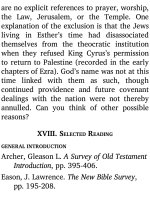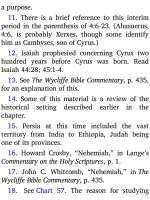Jensens survey of the old testament adam 349
Bạn đang xem bản rút gọn của tài liệu. Xem và tải ngay bản đầy đủ của tài liệu tại đây (117.54 KB, 4 trang )
hidden. With patience you will not give in to
such enemies as discouragement and
weariness.
A fresh approach is important in Bible
study. In survey, read the book as though
you have never read it before, in order to
awaken your heart and mind from the
dangerous sleep of letting the fantastic,
earth-shaking story of the evangel become
commonplace, trite, and ordinary.
Some of the things that you will be doing
in the three stages of survey study are
described below.2
1 . Stage One: Getting acquainted with the
book.
a. Scanning. Scan the book in one sitting
if possible. This is the cursory reading,
intended to break the ice, launch you
on your project, and give you a taste of
good things to come. It is not
necessary to read every word or line at
this time, especially of long books. If
your Bible has paragraph divisions,
reading the first sentence of each
paragraph will suffice. If your Bible
has chapter or paragraph headings,
note those as you scan the book.
b. First Impressions. Write down your
first impressions of the book. First
impressions are not always enduring,
nevertheless, they are necessary. You
should always seek to be impressed,
although you do not need to ask
yourself in machine-like regularity,
“How does this impress me?” The
question is pertinent at the close of
your reading; during the course of
reading, maintain a spirit of openness
and pliability so that you can be
impressed.
c. Atmosphere. Try to identify the
atmosphere of the book as a whole.
This is not always detectable at an
early stage. Atmosphere words are
tone words, such as love, conflict.
d. Keys. List any key words and phrases
that stand out as of this first reading.
You may not find many of these in this
first reading. But you will notice some.
2 . Stage Two: Working with the individual
segments.
a. Using the set of segment divisions
supplied by this manual,3 scan each of
the segments and determine the main
subject of each. (A segment is a group
of paragraphs that represents a unit of
thought. A segment may be longer or
shorter than a chapter.4)
NOMENCLATURE OF BOOK UNITS
b. Assign a segment title to each unit and
record these on paper. (A segment title
is a strong or picturesque word or
short phrase, preferably taken from the
text, intended to serve as a clue to at
least one main part of the segment. For
example, a segment title for Hebrews
1:1—2:4 could be Angels.) The value of
this step of survey is not only in the
segment title itself, but also in the
mental process of beginning to identify
parts and movements of the book.
c. Now that you have begun to look at









